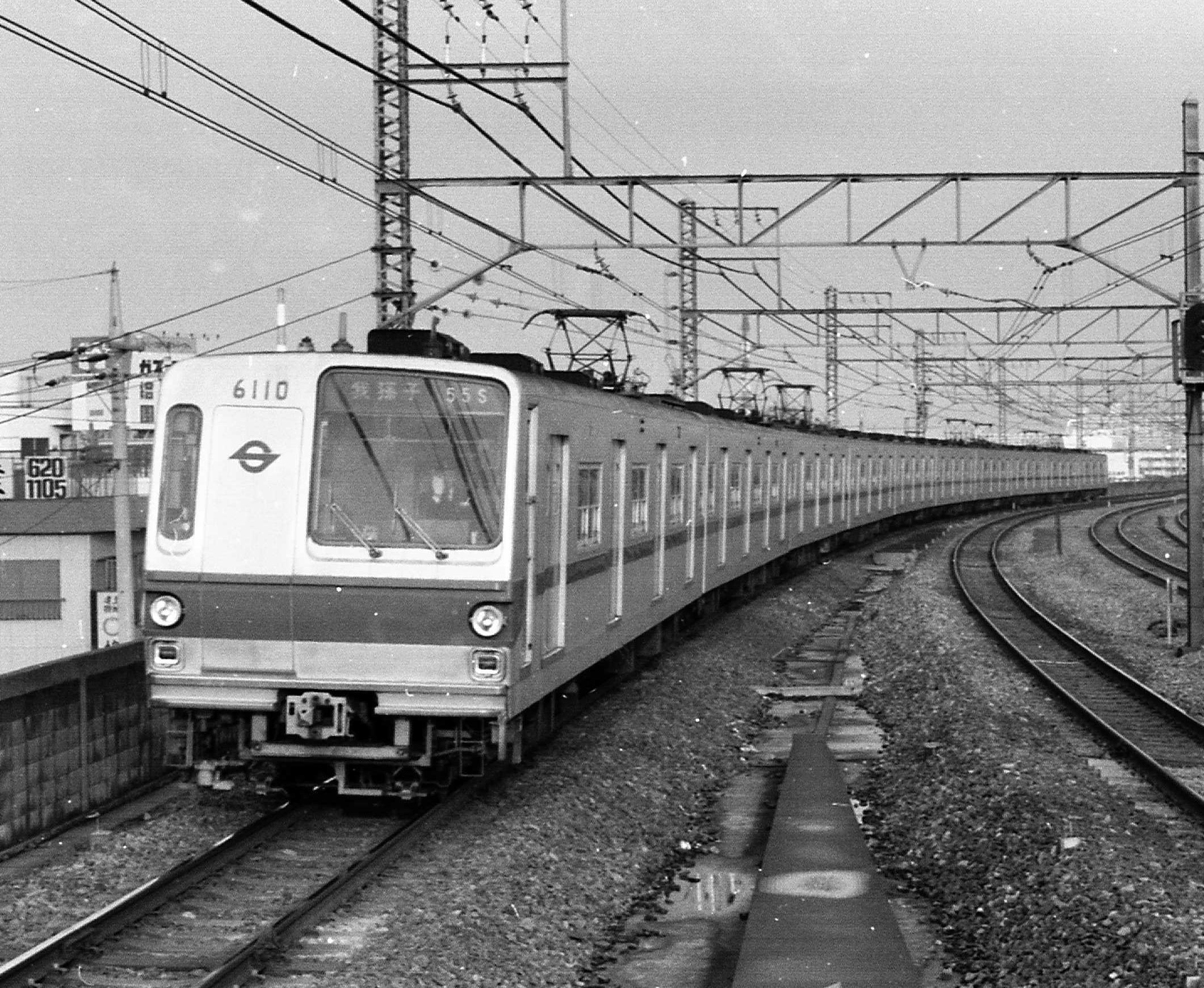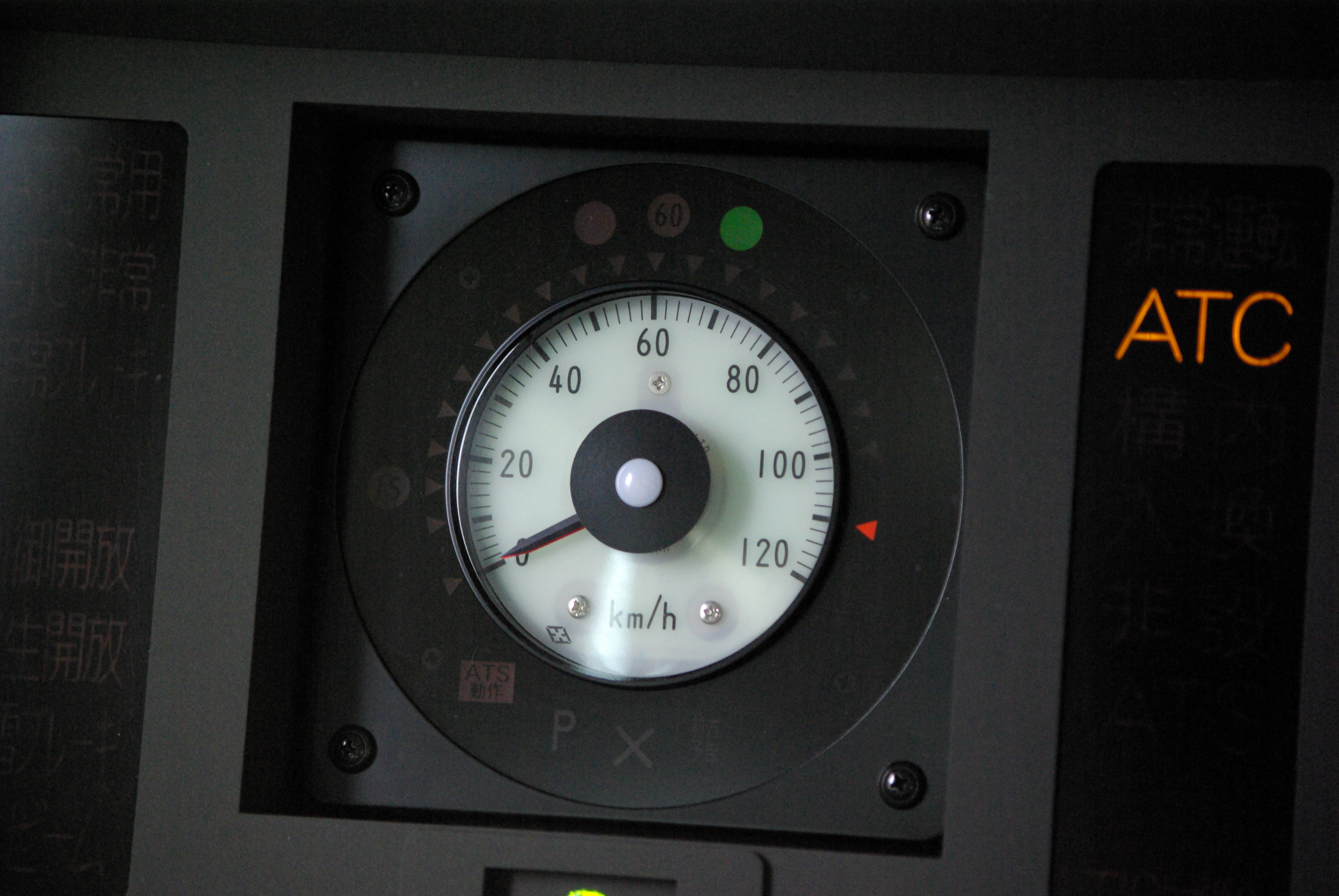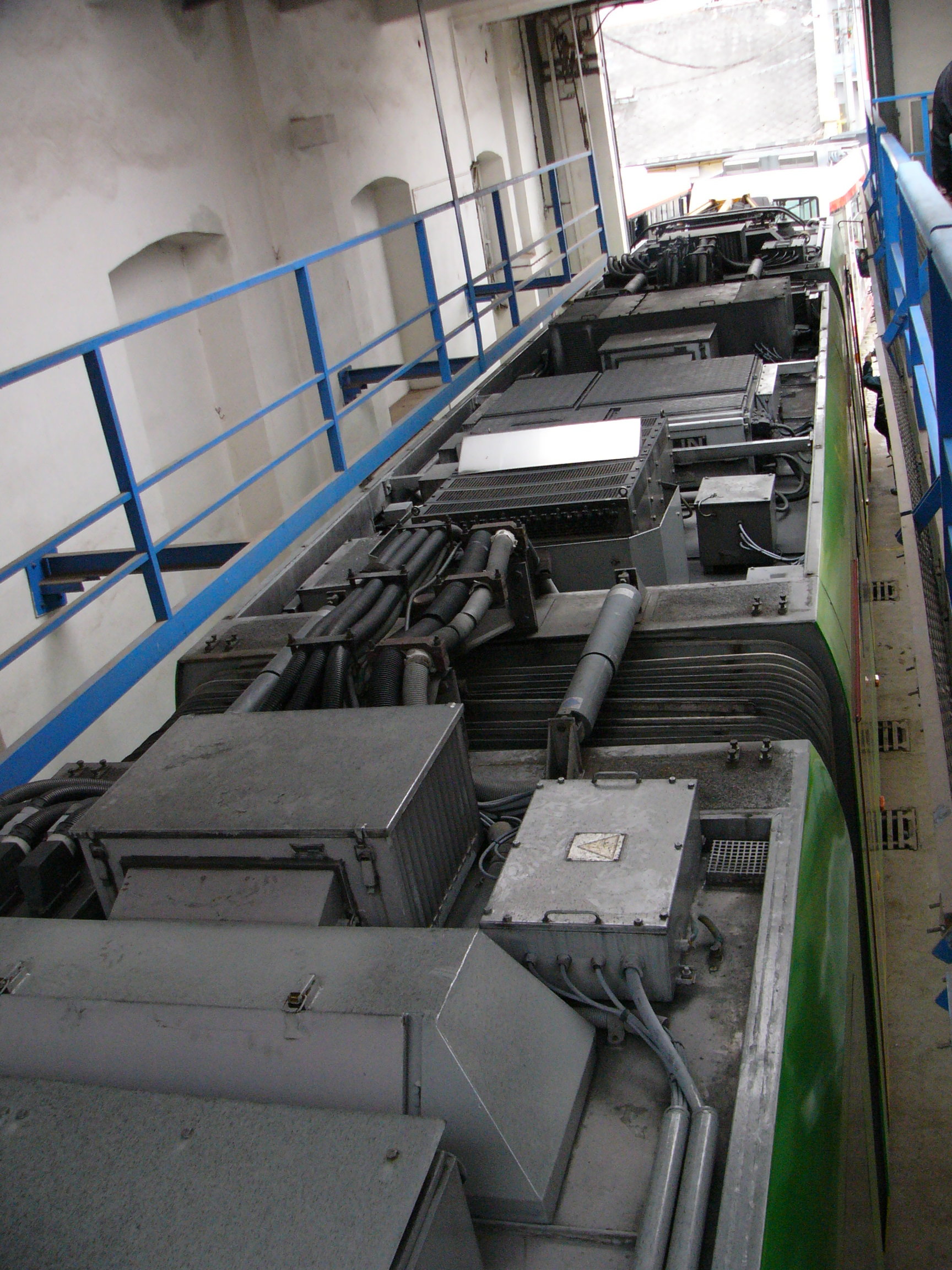|
Tokyo Metro 03 Series
The was an electric multiple unit (EMU) train type operated by the Tokyo subway operator Tokyo Metro in Tokyo, Japan. A total of 42 eight-car trainsets were built, between 1988 and 1994, entering service on 1 July 1988 and the final sets were withdrawn by 8 February 2020. Operations The 03 series trains operated on the Tokyo Metro Hibiya Line, with through-running to and from the Tobu Skytree Line and before 2013, on the Tokyu Toyoko Line. Formations , the fleet consisted of 40 eight-car sets, formed as shown below, with car 1 at the Naka-Meguro (south) end. Sets consisted of four motored ("M") cars and four non-powered trailer ("T") cars. * The M1 cars (cars 2 and 6) each had two lozenge-style pantographs. * Cars 1, 2, 7, and 8 in sets 09 to 28 had five pairs of doors per side instead of three. File:TRTA SERIES03 03113F.JPG, Set 13 in October 2008, with five-door end cars File:Hibiya Linie 5DOORS position.PNG, A position marker at a Hibiya Line station for the 5-door ... [...More Info...] [...Related Items...] OR: [Wikipedia] [Google] [Baidu] |
Kawasaki Heavy Industries
is a Japanese Public company, public multinational corporation manufacturer of motorcycles, engines, Heavy equipment (construction), heavy equipment, aerospace and Military, defense equipment, rolling stock and ships, headquartered in Minato, Tokyo, Minato, Tokyo, Japan. It is also active in the production of industrial robots, gas turbines, pumps, boilers and other industrial products. The company is named after its founder, Kawasaki Shōzō, Shōzō Kawasaki. KHI is known as one of the three major heavy industrial manufacturers of Japan, alongside Mitsubishi Heavy Industries and IHI Corporation, IHI. Prior to the World War II, Second World War, KHI was part of the Kobe Kawasaki ''zaibatsu'', which included JFE Holdings, Kawasaki Steel and K Line, Kawasaki Kisen. After the conflict, KHI became part of the DKB Group (''keiretsu''). History Kawasaki Shōzō, Shōzō Kawasaki, born in 1836, was involved with the marine industry from a young age. He was involved with two offshore ... [...More Info...] [...Related Items...] OR: [Wikipedia] [Google] [Baidu] |
Insulated Gate Bipolar Transistor
An insulated-gate bipolar transistor (IGBT) is a three-terminal power semiconductor device primarily forming an electronic switch. It was developed to combine high efficiency with fast switching. It consists of four alternating layers (NPNP) that are controlled by a metal–oxide–semiconductor (MOS) gate structure. Although the structure of the IGBT is topologically similar to a thyristor with a " MOS" gate ( MOS-gate thyristor), the thyristor action is completely suppressed, and only the transistor action is permitted in the entire device operation range. It is used in switching power supplies in high-power applications: variable-frequency drives (VFDs) for motor control in electric cars, trains, variable-speed refrigerators, and air conditioners, as well as lamp ballasts, arc-welding machines, photovoltaic and hybrid inverters, uninterruptible power supply systems (UPS), and induction stoves. Since it is designed to turn on and off rapidly, the IGBT can synthesize complex ... [...More Info...] [...Related Items...] OR: [Wikipedia] [Google] [Baidu] |
Kumamoto Prefecture
is a Prefectures of Japan, prefecture of Japan located on the island of Kyūshū. Kumamoto Prefecture has a population of 1,748,134 () and has a geographic area of . Kumamoto Prefecture borders Fukuoka Prefecture to the north, Ōita Prefecture to the northeast, Miyazaki Prefecture to the southeast, and Kagoshima Prefecture to the south. Kumamoto is the capital and largest city of Kumamoto Prefecture, with other major cities including Yatsushiro, Kumamoto, Yatsushiro, Amakusa, Kumamoto, Amakusa, and Tamana, Kumamoto, Tamana. Kumamoto Prefecture is located in the center of Kyūshū on the coast of the Ariake Sea, across from Nagasaki Prefecture, with the mainland separated from the East China Sea by the Amakusa Archipelago. Kumamoto Prefecture is home to Mount Aso, the largest active volcano in Japan and among the largest in the world, with its peak above sea level. History Historically, the area was called Higo Province; and the province was renamed Kumamoto during the Meij ... [...More Info...] [...Related Items...] OR: [Wikipedia] [Google] [Baidu] |
Tokyo Metro 6000 Series
The is an electric multiple unit (EMU) train type formerly operated by the Tokyo subway operator Tokyo Metro on the Tokyo Metro Chiyoda Line in Tokyo, Japan from 1971 to 2018. A number of trainsets have been exported to Indonesia for use by Kereta Commuter Indonesia following their withdrawal in Japan. The trains have aluminium 4-door cars, and are used on the Chiyoda Line, as well as Odakyu Odawara Line, and Joban Line (all-stations "local" services). The sole three-car set was used on the Chiyoda Line Kita-Ayase branch line. Fleet * 6000: 1st prototype (1968) * 6101: 2nd prototype (1969) * 6102–6121: full production 1st–3rd full-production batch type * 6122–6135: full production 4th–7th full-production batch type , the remaining fleet still operating in Japan consisted of 2 ten-car sets (sets 02 and 30). The 6000 series was scheduled for its final commercial operation on 13 October 2018. They were finally retired from service on 11 November 2018, after their final ... [...More Info...] [...Related Items...] OR: [Wikipedia] [Google] [Baidu] |
Railfan
A railfan, train fan, rail buff or train buff (American English), railway enthusiast, railway buff, anorak (British English), gunzel (Australian English), trainspotter (British English) or ferroequinologist is a person who is recreationally interested in trains and rail transport systems. Railfans often combine their interest with other hobbies, especially photography and videography, radio scanning, railway modelling, studying railroad history and participating in railway station and rolling stock preservation efforts. There are many magazines and websites dedicated to railfanning and railway enthusiasts, including ''Trains'', '' Railfan & Railroad'', ''The Railway Magazine'', '' Locomotive Magazine'' and ''Railway Gazette International''. Other names In the United Kingdom, rail enthusiasts are often called trainspotters or anoraks. The term ''gricer'' has been used in the UK since at least 1969 and is said to have been current in 1938 amongst members of the Manchester Lo ... [...More Info...] [...Related Items...] OR: [Wikipedia] [Google] [Baidu] |
Pantograph (rail)
A pantograph (or "pan" or "panto") is an apparatus mounted on the roof of an electric train, tram or trolley buses to collect power through contact with an overhead line. The term stems from the resemblance of some styles to the mechanical pantographs used for copying handwriting and drawings. The pantograph is a common type of current collector; typically, a single or double wire is used, with the return current running through the rails. Other types of current collectors include the bow collector and the trolley pole. Invention The pantograph, with a low-friction, replaceable graphite contact strip or "shoe" to minimise lateral stress on the contact wire, first appeared in the late 19th century. Early versions include the bow collector, invented in 1889 by Walter Reichel, chief engineer at Siemens & Halske in Germany, and a flat slide-pantograph first used in 1895 by the Baltimore and Ohio Railroad. The familiar diamond-shaped roller pantograph was devised and p ... [...More Info...] [...Related Items...] OR: [Wikipedia] [Google] [Baidu] |
Electric Multiple Unit
An electric multiple unit or EMU is a multiple-unit train consisting of self-propelled carriages using electricity as the motive power. An EMU requires no separate locomotive, as electric traction motors are incorporated within one or a number of the carriages. An EMU is usually formed of two or more semi-permanently coupled carriages. However, electrically powered single-unit railcars are also generally classed as EMUs. The vast majority of EMUs are passenger trains but versions also exist for carrying mail. EMUs are popular on intercity, commuter, and suburban rail networks around the world due to their fast acceleration and pollution-free operation, and are used on most rapid-transit systems. Being quieter than diesel multiple units (DMUs) and locomotive-hauled trains, EMUs can operate later at night and more frequently without disturbing nearby residents. In addition, tunnel design for EMU trains is simpler as no provision is needed for exhausting fumes, although retrofitting ... [...More Info...] [...Related Items...] OR: [Wikipedia] [Google] [Baidu] |
Janney Coupler
Knuckle couplers are a semi-automatic form of railway coupling that allow rail cars and locomotives to be securely linked together without rail workers having to get between the vehicles. Originally known as Janney couplers (the original patent name) they are almost always referred to as Knuckles in the US and Canada (regardless of their actual official model name, nowadays generally various AAR types in North America), but are also known as American, AAR, APT, ARA, MCB, Buckeye, tightlock (in the UK) or Centre Buffer Couplers. There are many variations of knuckle coupler in use today, and even more from the past, some variants of knuckle couplers include: Janney: the American original, a rather finicky coupler; reportedly annoying to make open and close. This design was obsolete by 1900. MCB: In the latter 1880's the Master Car Builder's Association (MCB) were faced with choosing a standard from the multitude of mutually incompatible automatic coupler designs then on offer. The ... [...More Info...] [...Related Items...] OR: [Wikipedia] [Google] [Baidu] |
Automatic Train Stop
Automatic train stop or ATS is a system on a train that automatically stops a train if certain situations occur (unresponsive train operator, earthquake, disconnected rail, train running over a stop signal, etc.) to prevent accidents. In some scenarios it functions as a type of dead man's switch. Automatic train stop differs from the concept of Automatic Train Control in that ATS usually does not feature an onboard speed control mechanism. Overview Mechanical systems The invention of the fail-safe railway air brake provided an external means for stopping a train via a physical object opening a valve on the brake line to the atmosphere. Eventually known as ''train stops'' or ''trip stops'', the first mechanical ATS system was installed in France in 1878 with some railroads in Russia following suit using a similar system in 1880. In 1901 Union Switch and Signal Company developed the first North American automatic train stop system for the Boston Elevated Railway. This system was s ... [...More Info...] [...Related Items...] OR: [Wikipedia] [Google] [Baidu] |
CS-ATC
Automatic train control (ATC) is a general class of train protection systems for railways that involves a speed control mechanism in response to external inputs. For example, a system could effect an emergency brake application if the driver does not react to a signal at danger. ATC systems tend to integrate various cab signalling technologies and they use more granular deceleration patterns in lieu of the rigid stops encountered with the older automatic train stop (ATS) technology. ATC can also be used with automatic train operation (ATO) and is usually considered to be the safety-critical part of a railway system. There have been numerous different safety systems referred to as "automatic train control" over time. The first experimental apparatus was installed on the Henley branch line in January 1906 by the Great Western Railway, although it would now be referred to as an automatic warning system (AWS) because the driver retained full command of braking. The term is especial ... [...More Info...] [...Related Items...] OR: [Wikipedia] [Google] [Baidu] |
Regenerative Braking
Regenerative braking is an energy recovery mechanism that slows down a moving vehicle or object by converting its kinetic energy or potential energy into a form that can be either used immediately or stored until needed. Typically, regenerative brakes work by driving an electric motor in reverse to recapture energy that would otherwise be lost as heat during braking, effectively turning the traction motor into a generator. Feeding power backwards through the system like this allows the energy harvested from deceleration to resupply an energy storage solution such as a battery or a capacitor. Once stored, this power can then be later used to aid forward propulsion. Because of the electrified vehicle architecture required for such a braking system, automotive regenerative brakes are most commonly found on hybrid and electric vehicles. This method contrasts with conventional braking systems, where excess kinetic energy is converted to unwanted and wasted heat due to friction i ... [...More Info...] [...Related Items...] OR: [Wikipedia] [Google] [Baidu] |







